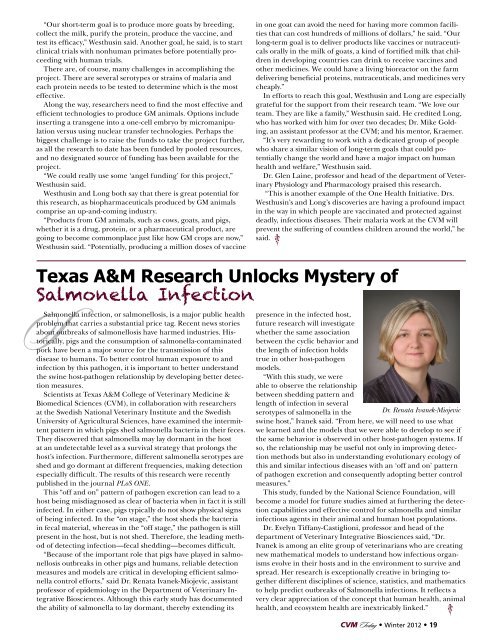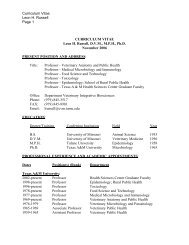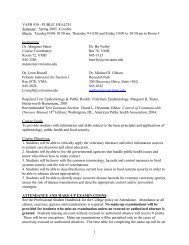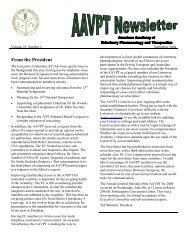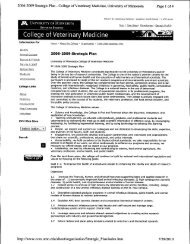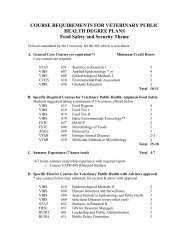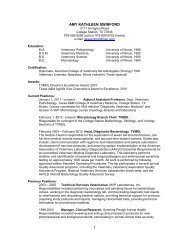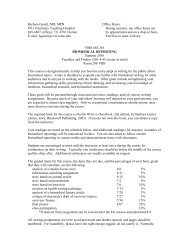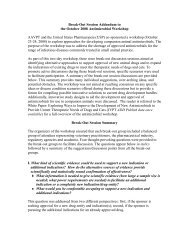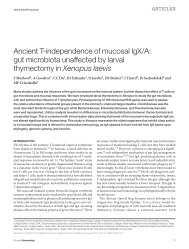Download PDF - College of Veterinary Medicine - Texas A&M ...
Download PDF - College of Veterinary Medicine - Texas A&M ...
Download PDF - College of Veterinary Medicine - Texas A&M ...
You also want an ePaper? Increase the reach of your titles
YUMPU automatically turns print PDFs into web optimized ePapers that Google loves.
“Our short-term goal is to produce more goats by breeding,<br />
collect the milk, purify the protein, produce the vaccine, and<br />
test its efficacy,” Westhusin said. Another goal, he said, is to start<br />
clinical trials with nonhuman primates before potentially proceeding<br />
with human trials.<br />
There are, <strong>of</strong> course, many challenges in accomplishing the<br />
project. There are several serotypes or strains <strong>of</strong> malaria and<br />
each protein needs to be tested to determine which is the most<br />
effective.<br />
Along the way, researchers need to find the most effective and<br />
efficient technologies to produce GM animals. Options include<br />
inserting a transgene into a one-cell embryo by micromanipulation<br />
versus using nuclear transfer technologies. Perhaps the<br />
biggest challenge is to raise the funds to take the project further,<br />
as all the research to date has been funded by pooled resources,<br />
and no designated source <strong>of</strong> funding has been available for the<br />
project.<br />
“We could really use some ‘angel funding’ for this project,”<br />
Westhusin said.<br />
Westhusin and Long both say that there is great potential for<br />
this research, as biopharmaceuticals produced by GM animals<br />
comprise an up-and-coming industry.<br />
“Products from GM animals, such as cows, goats, and pigs,<br />
whether it is a drug, protein, or a pharmaceutical product, are<br />
going to become commonplace just like how GM crops are now,”<br />
Westhusin said. “Potentially, producing a million doses <strong>of</strong> vaccine<br />
S<br />
Salmonella infection, or salmonellosis, is a major public health<br />
problem that carries a substantial price tag. Recent news stories<br />
about outbreaks <strong>of</strong> salmonellosis have harmed industries. Historically,<br />
pigs and the consumption <strong>of</strong> salmonella-contaminated<br />
pork have been a major source for the transmission <strong>of</strong> this<br />
disease to humans. To better control human exposure to and<br />
infection by this pathogen, it is important to better understand<br />
the swine host-pathogen relationship by developing better detection<br />
measures.<br />
Scientists at <strong>Texas</strong> A&M <strong>College</strong> <strong>of</strong> <strong>Veterinary</strong> <strong>Medicine</strong> &<br />
Biomedical Sciences (CVM), in collaboration with researchers<br />
at the Swedish National <strong>Veterinary</strong> Institute and the Swedish<br />
University <strong>of</strong> Agricultural Sciences, have examined the intermittent<br />
pattern in which pigs shed salmonella bacteria in their feces.<br />
They discovered that salmonella may lay dormant in the host<br />
at an undetectable level as a survival strategy that prolongs the<br />
host’s infection. Furthermore, different salmonella serotypes are<br />
shed and go dormant at different frequencies, making detection<br />
especially difficult. The results <strong>of</strong> this research were recently<br />
published in the journal PLoS ONE.<br />
This “<strong>of</strong>f and on” pattern <strong>of</strong> pathogen excretion can lead to a<br />
host being misdiagnosed as clear <strong>of</strong> bacteria when in fact it is still<br />
infected. In either case, pigs typically do not show physical signs<br />
<strong>of</strong> being infected. In the “on stage,” the host sheds the bacteria<br />
in fecal material, whereas in the “<strong>of</strong>f stage,” the pathogen is still<br />
present in the host, but is not shed. Therefore, the leading method<br />
<strong>of</strong> detecting infection—fecal shedding—becomes difficult.<br />
“Because <strong>of</strong> the important role that pigs have played in salmonellosis<br />
outbreaks in other pigs and humans, reliable detection<br />
measures and models are critical in developing efficient salmonella<br />
control efforts,” said Dr. Renata Ivanek-Miojevic, assistant<br />
pr<strong>of</strong>essor <strong>of</strong> epidemiology in the Department <strong>of</strong> <strong>Veterinary</strong> Integrative<br />
Biosciences. Although this early study has documented<br />
the ability <strong>of</strong> salmonella to lay dormant, thereby extending its<br />
in one goat can avoid the need for having more common facilities<br />
that can cost hundreds <strong>of</strong> millions <strong>of</strong> dollars,” he said. “Our<br />
long-term goal is to deliver products like vaccines or nutraceuticals<br />
orally in the milk <strong>of</strong> goats, a kind <strong>of</strong> fortified milk that children<br />
in developing countries can drink to receive vaccines and<br />
other medicines. We could have a living bioreactor on the farm<br />
delivering beneficial proteins, nutraceuticals, and medicines very<br />
cheaply.”<br />
In efforts to reach this goal, Westhusin and Long are especially<br />
grateful for the support from their research team. “We love our<br />
team. They are like a family,” Westhusin said. He credited Long,<br />
who has worked with him for over two decades; Dr. Mike Golding,<br />
an assistant pr<strong>of</strong>essor at the CVM; and his mentor, Kraemer.<br />
“It’s very rewarding to work with a dedicated group <strong>of</strong> people<br />
who share a similar vision <strong>of</strong> long-term goals that could potentially<br />
change the world and have a major impact on human<br />
health and welfare,” Westhusin said.<br />
Dr. Glen Laine, pr<strong>of</strong>essor and head <strong>of</strong> the department <strong>of</strong> <strong>Veterinary</strong><br />
Physiology and Pharmacology praised this research.<br />
“This is another example <strong>of</strong> the One Health Initiative. Drs.<br />
Westhusin’s and Long’s discoveries are having a pr<strong>of</strong>ound impact<br />
in the way in which people are vaccinated and protected against<br />
deadly, infectious diseases. Their malaria work at the CVM will<br />
prevent the suffering <strong>of</strong> countless children around the world,” he<br />
said.<br />
<strong>Texas</strong> A&M Research Unlocks Mystery <strong>of</strong><br />
Salmonella Infection<br />
presence in the infected host,<br />
future research will investigate<br />
whether the same association<br />
between the cyclic behavior and<br />
the length <strong>of</strong> infection holds<br />
true in other host-pathogen<br />
models.<br />
“With this study, we were<br />
able to observe the relationship<br />
between shedding pattern and<br />
length <strong>of</strong> infection in several<br />
serotypes <strong>of</strong> salmonella in the Dr. Renata Ivanek-Miojevic<br />
swine host,” Ivanek said. “From here, we will need to use what<br />
we learned and the models that we were able to develop to see if<br />
the same behavior is observed in other host-pathogen systems. If<br />
so, the relationship may be useful not only in improving detection<br />
methods but also in understanding evolutionary ecology <strong>of</strong><br />
this and similar infectious diseases with an ‘<strong>of</strong>f and on’ pattern<br />
<strong>of</strong> pathogen excretion and consequently adopting better control<br />
measures.”<br />
This study, funded by the National Science Foundation, will<br />
become a model for future studies aimed at furthering the detection<br />
capabilities and effective control for salmonella and similar<br />
infectious agents in their animal and human host populations.<br />
Dr. Evelyn Tiffany-Castiglioni, pr<strong>of</strong>essor and head <strong>of</strong> the<br />
department <strong>of</strong> <strong>Veterinary</strong> Integrative Biosciences said, “Dr.<br />
Ivanek is among an elite group <strong>of</strong> veterinarians who are creating<br />
new mathematical models to understand how infectious organisms<br />
evolve in their hosts and in the environment to survive and<br />
spread. Her research is exceptionally creative in bringing together<br />
different disciplines <strong>of</strong> science, statistics, and mathematics<br />
to help predict outbreaks <strong>of</strong> Salmonella infections. It reflects a<br />
very clear appreciation <strong>of</strong> the concept that human health, animal<br />
health, and ecosystem health are inextricably linked.”<br />
CVM Today • Winter 2012 • 19


